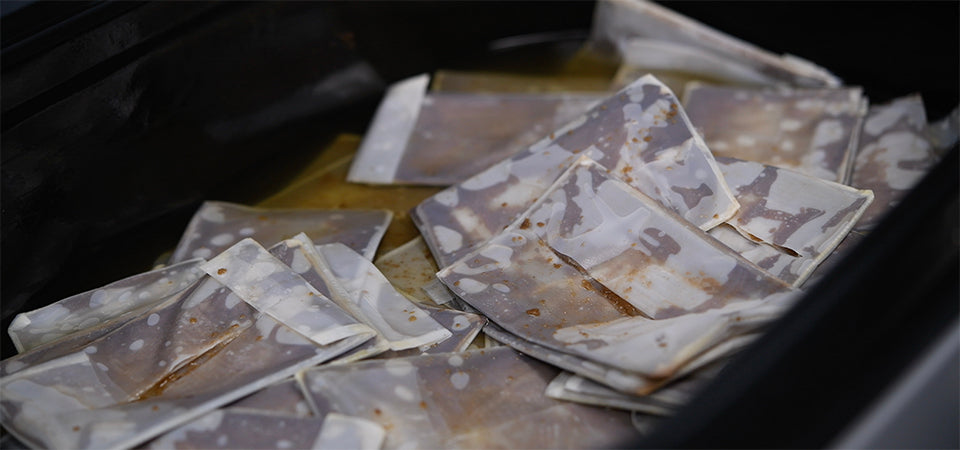Rosin Chips - What They Are & How to Use Them

Rosin chips, also called rosin pucks, are the flat discs that are left over after pressing cannabis flower, sift, or hash in a rosin press. While most of the cannabinoids and terpenes are removed when you press rosin, a small amount will inevitably be left—especially in the ring of rosin that remains around the primary rosin chip in the bag.
There are several things you can do with your leftover chips to squeeze the last active compounds (and revenue) out of them for sale or personal use. For maximum efficiency, collect rosin chips until you have at least a dozen—the more the better—and process them all at once.
What Are Rosin Chips Made Of?

The exact composition of a rosin chip will depend on the starting material.
- Flower rosin chips contain plant material, trichome cuticles, and residual resin.
- Sift and hash rosin chips are primarily made up of trichome cuticles and residual resin.
Keep in mind that rosin chips from flower will produce derivative products that are green in color whereas rosin chips from sift and bubble hash will produce golden-color derivative products.
How to Use Rosin Chips
The following are our favorite ways to use rosin chips:
- Re-press the chips
- Use a solvent to extract the rest of the active compounds
- Make rosin salve
- Make infused coconut oil
- Make MCT capsules
- Make cannabutter
- Make rosin chip tinctures
Re-Press Your Rosin Chips
A second press will generally remove most of the residual resin from your rosin pucks. This resin will be of a lower quality than first-press rosin—whereas first-press rosin is generally dabbed, second-press rosin is best vaped or sprinkled into pre-rolls.
To re-press rosin chips:
- Place the spent rosin bag inside a new piece of folded parchment paper.
- Press on a rosin press at 190-210°F with more pressure than you would apply to a first press.
- Store the rosin in a mason jar in the fridge for further processing.
- Gather your double-pressed rosin chips for further processing with any of the other techniques presented below.
Extract the Remaining Compounds With Solvents
Solvents can be used to extract the remaining compounds in cannabis rosin chips if you have both solvent and solventless extraction equipment. Some people use ethanol and turn the extract into distillate. Others prefer to blast the chips with butane in a closed-loop extraction system and make BHO.
Either way, it's best to wait until you have a large quantity of rosin chips to get a decent output from solvent extraction. Remember that you'll also need to test and dose your extract before packaging it and distributing it to dispensaries.
Make Rosin Salve

Rosin salve (or balm) is an easy topical product to make with rosin chips at home. We demonstrate the process in our video How to Make Rosin Salve/Balm.
To make rosin salve, melt coconut oil in a crock pot, slice your rosin chips open and submerge them fully in the melted coconut oil. Allow the contents of the rosin chips to infuse into the oil for 4 hours at 250°F.
Then, add shea butter, reduce the heat to a minimum, and add essential oils (and optionally emu oil) while the oil is cooling down. Filter the mixture into a mason jar through a funnel and 25μm rosin bag, use an immersion blender to homogenize the mixture, and refrigerate overnight before use.
Check out our step-by-step instructions for making cannabis salve.
Make Infused Coconut Oil
The first part of our rosin chip salve recipe (infusing opened rosin chips in coconut oil in a crock pot for 4 hours) gives you infused coconut oil, which you can use to make edibles, topicals, and even soap. Infused coconut oil is similar to cannabutter in that the fats bind to the cannabinoids and help with absorption. The difference is that coconut oil can also be used in topicals whereas not many people would want to lather cannabutter on their skin.
Decarboxylate Your Rosin Chips for Edibles
Rosin chips will need to be decarbed if you want to use them for edibles or topicals. In our rosin chip salve recipe, the cannabis decarbs during the cooking process. However, for cannabutter, you'll need to decarb the rosin chips first to activate the THC. To decarboxylate your rosin chips:
- Preheat the oven to 220°F.
- Open the spent rosin bags and break the rosin chips into small pieces.
- Spread the small pieces across a baking tray lined with food-grade parchment paper. You can include these pieces alongside other cannabis material if you are decarbing larger batches for edibles and infusions.
- Bake for around 30 minutes.
- Remove the tray from the oven and allow the rosin chip pieces to cool.
Cannabutter

Cannabutter provides the basis for infused edibles like brownies, cookies and other baked goods, sauces, and mac and cheese. You'll need to decarb your rosin chips before using them to make cannabutter and ensure a ratio of one stick of butter to every ounce of cannabis material.
- Simmer the butter and the same amount of water in a saucepan on low heat until the butter melts. The water is essential because it helps to keep the butter from burning.
- Add the decarbed rosin chips and simmer for two hours on minimum heat. The mixture should only be simmering and shouldn't come to a boil. In commercial operations, you can use a mixture of decarbed rosin chips and other decarbed cannabis material to make larger amounts of cannabutter.
- Turn the heat off and allow the contents of the saucepan to cool. The butter should float to the top.
- As an optional step, scoop the cannabutter off the top and let it simmer with 1 tsp of sunflower lecithin in a skillet until they can be whisked together. The addition of lecithin increases the bioavailability of the cannabinoids.
- Cover a funnel with cheesecloth and put the end of the funnel inside a heat-resistant glass jar.
- Pour the mixture through the cheesecloth and into the jar. Don't try to force the mixture through the cheesecloth as you may end up with plant material in your cannabutter.
- Put the mixture in the fridge for around one hour. Once the butter cools, you can carefully drain off any excess water.
MCT Oil Capsules
MCT oil capsules are another great use for rosin chips. MCT stands for medium-chain triglycerides, which are fats that help with cannabinoid absorption. You can buy concentrated MCT oil or use coconut oil. However, commercial coconut oil contains mostly lauric acid rather than MCTs and isn’t absorbed as quickly. The process is as follows:
- Decarb your rosin chips. You can also decarb rosin and infuse that into MCT oil instead.
- Infuse the rosin chips into the MCT oil in the crock pot (steps 1-8 of the rosin salve recipe, except with MCT oil rather than commercial coconut oil).
- Allow the infused oil to cool completely. Meanwhile, try a small amount of oil (around 0.1g) with a syringe and wait for 45 minutes for the effects to kick in. This will help you assess the potency of your oil. If producing MCT oil capsules commercially, you'll need to have your infused oil tested to determine the potency (and ideal dosage) accurately.
- Once it has cooled (and you've determined the dosage), use another syringe to place this dose of infused oil into capsules split in half. You can use a capsule filling machine or stand half capsules in a bowl of rice to keep them still while you fill them with oil. It's important not to overfill the capsules because they could split when you fit the halves together.
- Fit the tops onto the capsules and press the two halves firmly together.
- Store the capsules in an airtight jar in the fridge.
Rosin Chip Tinctures
Tinctures are made by soaking plant material in alcohol to dissolve the active compounds. You can make rosin chip tinctures with 151-proof or 190-proof Everclear.
- Decarboxylate the rosin chips as described.
- Put the decarboxylated rosin chip pieces in a glass jar.
- Add alcohol until the pieces are submerged.
- Leave the cannabis pieces to soak for one to three months. Shake the jar a few times a day.
- Pour the liquid into a dark-colored glass bottle through a 25μm rosin bag to strain it.
- To use, place a couple of drops of tincture under the tongue and allow the cannabinoids to absorb into the bloodstream.
Squeeze Out Every Last Drop
Rosin chips can be a great supplemental source of cannabis material once you build up a decent number of them. Whether for sale to consumers or personal use, the techniques listed above will allow you to squeeze out every last drop of goodness from your starting material.
The trick with using rosin chips is to process as many as possible at once and automate your processes with equipment like crockpots and ovens with a timer. That way, you'll be able to supplement your revenue (or home stash) with a minimum of additional time and effort.



